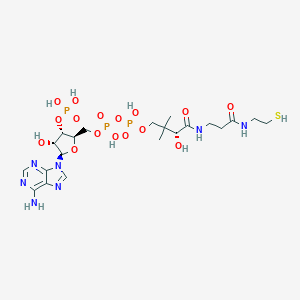| General Information of MET (ID: META00427) |
| Name |
Coenzyme A
|
| Synonyms |
Click to Show/Hide Synonyms of This Metabolite
18-CoA-18-oxo-Dinor-LTB4; 3'-Phosphoadenosine-(5')diphospho(4')pantatheine, '[(2R,3S,4R,5R)-5-(6-Amino-9H-purin-9-yl)-4-hydroxy-3-(phosphonooxy)tetrahydrofuran-2-yl]methyl (3R)-3-hydroxy-4-({3-oxo-3-[(2-sulfanylethyl)amino]propyl}amino)-2,2-dimethyl-4-oxobutyl dihydrogen diphosphate; Acetoacetyl coenzyme A sodium salt; CoA; CoA Hydrate; CoA-SH; CoASH; Coenzym a; Coenzyme A; Depot-zeel; HSCoA; Koenzym a; Propionyl CoA; Propionyl coenzyme A; S-Propanoate; S-Propanoate CoA; S-Propanoate coenzyme A; S-Propanoic acid; S-Propionate CoA; S-Propionate coenzyme A; Zeel; [(2R,3S,4R,5R)-5-(6-Amino-9H-purin-9-yl)-4-hydroxy-3-(phosphonooxy)tetrahydrofuran-2-yl]methyl (3R)-3-hydroxy-4-({3-oxo-3-[(2-sulfanylethyl)amino]propyl}amino)-2,2-dimethyl-4-oxobutyl dihydrogen diphosphoric acid; [(2R,3S,4R,5R)-5-(6-Amino-9H-purin-9-yl)-4-hydroxy-3-(phosphonooxy)tetrahydrofuran-2-yl]methyl (3R)-3-hydroxy-4-({3-oxo-3-[(2-sulphanylethyl)amino]propyl}amino)-2,2-dimethyl-4-oxobutyl dihydrogen diphosphate; [(2R,3S,4R,5R)-5-(6-Amino-9H-purin-9-yl)-4-hydroxy-3-(phosphonooxy)tetrahydrofuran-2-yl]methyl (3R)-3-hydroxy-4-({3-oxo-3-[(2-sulphanylethyl)amino]propyl}amino)-2,2-dimethyl-4-oxobutyl dihydrogen diphosphoric acid; a, Coenzyme; coenzyme A Hydrate; coenzyme A-SH; coenzyme ASH
|
| Source |
Endogenous;Escherichia Coli Metabolite;Yeast Metabolite;Food;Cosmetic;Microbial
|
| Structure Type |
Purine ribonucleotides (Click to Show/Hide the Complete Structure Type Hierarchy)
Nucleosides, nucleotides, and analogues
Purine nucleotides
Purine ribonucleotides
|
| PubChem CID |
|
| HMDB ID |
|
| Formula |
C21H36N7O16P3S
|
| Structure |
<iframe style="width: 300px; height: 300px;" frameborder="0" src="https://embed.molview.org/v1/?mode=balls&cid=87642"></iframe>
|
 |
|
3D MOL is unavailable
|
2D MOL
|
|
Click to Show/Hide the Molecular/Functional Data (External Links/Property/Function) of This Metabolite
|
| KEGG ID |
|
| DrugBank ID |
|
| ChEBI ID |
|
| FooDB ID |
|
| Physicochemical Properties |
Molecular Weight |
767.5 |
Topological Polar Surface Area |
348 |
| XlogP |
-5.8 |
Complexity |
1270 |
| Heavy Atom Count |
48 |
Rotatable Bond Count |
18 |
| Hydrogen Bond Donor Count |
10 |
Hydrogen Bond Acceptor Count |
21 |
| Function |
Coenzyme A (CoA, CoASH, or HSCoA) is a coenzyme notable for its role in the synthesis and oxidization of fatty acids and the oxidation of pyruvate in the citric acid cycle. It is adapted from beta-mercaptoethylamine, panthothenate, and adenosine triphosphate. It is also a parent compound for other transformation products, including but not limited to, phenylglyoxylyl-CoA, tetracosanoyl-CoA, and 6-hydroxyhex-3-enoyl-CoA. Coenzyme A is synthesized in a five-step process from pantothenate and cysteine. In the first step pantothenate (vitamin B5) is phosphorylated to 4'-phosphopantothenate by the enzyme pantothenate kinase (PanK, CoaA, CoaX). In the second step, a cysteine is added to 4'-phosphopantothenate by the enzyme phosphopantothenoylcysteine synthetase (PPC-DC, CoaB) to form 4'-phospho-N-pantothenoylcysteine (PPC). In the third step, PPC is decarboxylated to 4'-phosphopantetheine by phosphopantothenoylcysteine decarboxylase (CoaC). In the fourth step, 4'-phosphopantetheine is adenylylated to form dephospho-CoA by the enzyme phosphopantetheine adenylyl transferase (CoaD). Finally, dephospho-CoA is phosphorylated using ATP to coenzyme A by the enzyme dephosphocoenzyme A kinase (CoaE). Since coenzyme A is, in chemical terms, a thiol, it can react with carboxylic acids to form thioesters, thus functioning as an acyl group carrier. CoA assists in transferring fatty acids from the cytoplasm to the mitochondria. A molecule of coenzyme A carrying an acetyl group is also referred to as acetyl-CoA. When it is not attached to an acyl group, it is usually referred to as 'CoASH' or 'HSCoA'. Coenzyme A is also the source of the phosphopantetheine group that is added as a prosthetic group to proteins such as acyl carrier proteins and formyltetrahydrofolate dehydrogenase. Acetyl-CoA is an important molecule itself. It is the precursor to HMG CoA which is a vital component in cholesterol and ketone synthesis. Furthermore, it contributes an acetyl group to choline to produce acetylcholine in a reaction catalysed by choline acetyltransferase. Its main task is conveying the carbon atoms within the acetyl group to the citric acid cycle to be oxidized for energy production.
|
|
Regulatory Network
|
|
|
|
|
|
|
|
|
 click to show the details of this protein
click to show the details of this protein
 click to show the details of experiment for validating this pair
click to show the details of experiment for validating this pair

